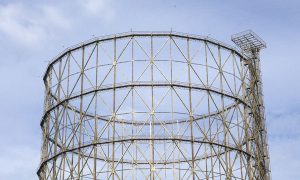
This year we should see the construction of a luxury housing development within the iconic gasometer by The Oval cricket ground – the historic grade II listed metal lattice that has looked down not only on countless classic cricket matches but also the first ever football international (England v Scotland, 1870), the first ever FA Cup Final (Wanderers v Royal Engineers, 1872) and the first rugby internationals.
Not surprisingly, then, any suggestion of demolishing the thing after it was decommissioned by the National Grid at the end of the last century has been met with outrage. Instead, a circular block of luxury apartments will be built within the metal framework and the owners will find that their free vantage point for the cricket comes with an obstructed view.
Gasometers have courted controversy ever since they first came into being in the 19th century. There’s the name, for a start. Derived from a pneumatic device invented by French scientist Antoine Lavoisier, which he called a ‘gazomètre’, it was adopted by William Murdoch, the inventor of gas lighting. His rivals, though, missing the point that the bloke had invented one of the most world-changing systems in human history, argued that he shouldn’t call his gas storage units gasometers because they weren’t meters at all.
So, if you prefer, you can call them ‘gas holders’, but if you have the merest scintilla of romance in your heart, it has to be ‘gasometer’. (Not to be confused with ‘guessometer’, which is the fantastically random instrument in an electric car that tells you how many miles you’ve got left from your battery).
Despite being dirty great rusty frameworks of iron, symbolising the industrial revolution, the burning of fossil fuels, air pollution, global warming and the threatened extinction of the polar bear, gasometers have somehow won the hearts of conservationists. No doubt it would surprise the Victorians who constructed them to know that they have become the subject of fierce philosophical debate as to their value as historical relics, but many of us who were alive when gasometers were still doing their thing regard them almost as sentient beings, probably because of their size and movement.
As a kid, you were always asking yourself how come this thing was a huge great metal tank when you went past it on the way to the park, but a hollow frame by the time you came home – like the exoskeleton of some gigantic cylindrical insect after its had its innards sucked out by an even more gigantic spider. That’s what I assumed had happened anyway.
The discovery of natural gas in the North Sea meant we no longer needed to store gas in gasometers, and so the great dismantling began. There was value in the metal and the land on which they stood. Who could possibly stand in the way? But we had come to see a beauty in those delicate metal giants. No-one was going to take them down without a fight. So what to do with them? Unlike other obsolete Victorian industrial structures, converting them into characterful homes was not a straightforward solution. Who wants a house that slowly disappears at tea time?
In other parts of the world, this wasn’t a problem because they had built their gasometers inside brick walls. There are four in Vienna, for example, that have been converted into spectacular multi-use buildings, with homes at the top, offices in the middle and shopping malls at the bottom, connected by walkways. The ornate 19th century facades are kept intact in all their glory.
With our gasometers it’s a different story. They are, quite literally, great big cylinders of nothingness. But, like the gaps in a fork, it’s the nothing that gives them their impact. When the Oval gasometer is filled with luxury apartments, the nothing will be gone and we’ll have to look elsewhere for our emptiness.


